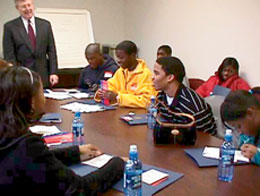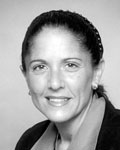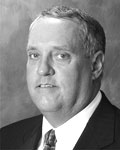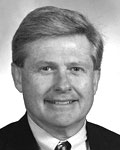 |
 |
 |
Skin in the game IIABA's InVEST program invites seasoned professionals to get involved in building the industry's future By Nancy Doucette Rod Evans knows first-hand that good help is hard to find. As the owner of three agencies in eastern North Carolina, he’d struggled to find individuals for staff positions. During his term as president of the Independent Insurance Agents of North Carolina, he heard from countless agents around the state that they too were having hiring difficulties, and it was affecting the success of their agencies. Thus began what Evans refers to as his “selfish interest in workforce development.” His research led him to a national program available through the Independent Insurance Agents and Brokers of America. Called InVEST, the program has been in existence since 1970. “I let it be known that I was interested in serving on the national InVEST board and in 2002, I became a board member,” he recalls. “Soon, I will complete my term as chair of the InVEST committee. I’ve become active in promoting insurance as a profession and in educating young people who will have the skills to begin their career in insurance.” Evans says he “sells” the InVEST program in much the same fashion as he sells a commercial account, beginning first by creating and nurturing relationships with educators. This approach has yielded good results. He reports that the InVEST program is in place in several high schools in Charlotte as well as several other locations around the state. According to Barbara Miller-Richards, who for many years headed up the IIABA’s Agent Development programs, the InVEST program educates students as consumers, and about careers in the insurance industry. InVEST is a 501(c)3 educational trust, which means it’s solely supported by contributions. InVEST has a high school and a community college curriculum. “We have a model set up with step-by-step guides on how to implement these programs in your community. The teaching materials are downloadable from the InVEST Web site,” she explains. “This program brings the insurance industry together with the education community.” The high school model, Miller-Richards continues, is often incorporated into an existing business class. It’s a simulation—a hands-on concept—where students begin by learning what risk is, what risk management is, and about the different distribution systems in the industry. Then the students form mock agencies and mock carrier home offices. “Most of these students are 17-year-olds,” she notes, “and there’s nothing more important than getting a car. This program helps them understand how insurance rates are developed and how underwriting decisions are made based on credit scores, MVRs, increased hazards.” So while the high school curriculum includes auto, homeowners, and BOP, most programs begin with the auto component. Miller-Richards says there’s a competition as students “sell” fictitious auto policies to family, friends, and classmates. Part of that process includes using a live online rating tool supplied by AMS. All of the students rotate through the different positions in both the mock agency and mock home office. “The community college program is more academic,” Miller-Richards explains, with the community college curriculum based on the INS and AAI courses from the Insurance Institute of America. “At the community college, a professor who is qualified to teach insurance facilitates the classes. Agents still need to be a part of the process, though, by doing mock job interviews or offering internships. Insurance professionals still need to volunteer as guest speakers to talk about what a career in insurance is like, how they got started in the business, and what the qualifications are.” Rod Evans maintains that introducing InVEST to high schools and community colleges isn’t difficult, but it does take time. However, he notes, “As agency owners it’s important for us to give back—to our communities and to the insurance industry. InVEST is an opportunity to give back and receive at the same time. That’s rare.” He recommends that fellow agents capitalize on the relationships they have with educators within their communities. Miller-Richards concurs. “Insurance is a people business,” she observes, “so agents who want to implement an InVEST program are naturally going to contact the people they know in the education community. For instance, the agent may be on the board of the local community college or play golf with one of the high school administrators. Or the agent may insure the school’s guidance counselor.” Guidance counselors are an important conduit for spreading the word about how vital the insurance industry is as an employer in the community, notes Roger Ronk, chief operating officer for the Independent Insurance Agents of Indiana (IIAI), and a long-time national InVEST board member. He’s aware of one state university that offers a course for guidance counselors about the insurance industry. By getting guidance counselors interested in the insurance industry, he says, they’ll be better able to interest students in the industry. For his part, Ronk has been spreading the word to educators about the significance of the insurance industry in his home state. Recently he made a presentation to a group of high school teachers who were attending an Insurance Education Institute as part of their master’s degree program. “I talked to them about the employment needs of the insurance industry—and specifically the needs in Indiana. I also spoke about InVEST—what it is, how it works—and how they could get involved if they wanted to start an InVEST program at their school,” he recalls. Following the presentation, he says, a number of the teachers expressed interest in setting up an InVEST program in the schools where they teach. An important component of any InVEST program is the independent agent, he reiterates—agents need to volunteer as guest speakers at schools with InVEST programs. But if you’re in a community without an InVEST program, and you’re planning on starting one, he suggests setting up a committee that includes local insurance professionals representing a cross section of groups—CPCUs, Insurance Women, a carrier representative, an agency representative, people who can be a resource, people who can provide field trips, and people who can be guest lecturers. Ronk points out that even without an InVEST program, there are still ways for agents to be a presence in the schools. “In Indiana, the IIAI developed a guide for youthful drivers that agents can take into a driver’s ed class. Making a driver training presentation is a good start. That gets you into the school, meeting the teachers. So if you don’t already have a relationship with the school system or an educator in that school system, this might be a good way of getting a toe in the water.” Indiana is, in fact, positioning itself as “the most attractive insurance employment state in the nation,” according to the Indiana Economic Development Corporation (IEDC). Surprised? Mike Chrysler, director of insurance initiatives for the IEDC, explains that the IEDC will devote $2 million a year to insurance training through its INSPIRE grant program—INdiana SPecific Insurance Related Education (www.in.gov/iedc/pdfs/INSPIRE.pdf ). Chrysler acknowledges that Indiana isn’t the only state with such a program, but he says it’s one of the most expansive. He recommends that agents check with their home state’s department of commerce or economic development corporation to see if a similar program is available. “States are looking for ways to diversify their economy,” he observes. “The insurance industry is an attractive alternative to manufacturing.” That observation is an important point to make when proposing an InVEST program to a high school or community college, notes Kent Daugherty, P&C marketing senior executive at Westfield Insurance, Westfield Center, Ohio, and another member of the national InVEST board. Westfield is a regional insurer, operating in 28 states. “Educators need a reason to put the InVEST program in their school,” he says. “So if you’re proposing a program, you need to have some facts and figures to support why young people should be trained in insurance.” “Big picture” numbers are available at the U.S. Department of Labor Bureau of Labor Statistics Web site (http://www.bls.gov/oco/cg/cgs028.htm) but it’s best to include local statistics—especially if you’re approaching a community college about setting up an InVEST program. “The goal of community colleges is to get their graduates into the workforce,” explains Barbara Miller-Richards. “Community colleges want to see information that demonstrates that there’s a viable employment market for students who complete the InVEST program. The statistics need to be localized, so you need to do a survey of insurance-related businesses within 50 to 100 miles of that community college to learn about their employment needs. For instance, will they be hiring in the next 18 to 24 months? What skills are they looking for? You would want to send the survey to the local CPCU chapter, the local NAIW chapter, and the local Big ‘I.’ Be sure to include regional or branch offices for carriers also.” Just like Rod Evans’ “selfish interest in workforce development,” carriers most likely have a similar motivation, although they might express it somewhat differently. Daugherty notes that Westfield’s revenue comes exclusively from independent agents so if the independent agency system doesn’t remain healthy and viable, that impacts the health of the carrier as well. One of the ways that Westfield delivers on its tag line of “Sharing Knowledge. Building Trust”® is by partnering with neighboring high schools in their InVEST programs. Westfield’s Agency Operations Director Brady Polansky spearheads the efforts. During the last school year, Westfield’s agency training team went to one school to present a “Jeopardy” game on the fundamentals of insurance. But Westfield isn’t alone in its involvement in the area schools. A number of its agents are active as well. This illustrates a good point, Daugherty says. “An agency owner doesn’t necessarily have to be the one doing the volunteering. Perhaps there’s someone in the agency with a passion for education. And there’s nothing like ‘peer to peer’ interaction. So if you have a young person on staff who is looking for a great way to ‘give back,’ InVEST is the answer.” Miller-Richards concludes: “It’s never too late to get an InVEST program up and running. So even if the school year is already underway, if you want to influence the future of the independent agency system, there’s always a time to start laying the groundwork for an InVEST program.” Author’s note: Barbara Miller-Richards, who headed up the IIABA’s Agent Development programs, recently accepted another position within the IIABA. Going forward, management of the Agent Development programs will be under the direction of William N. Pierson, CPCU. * For more information: |
|
|||||||||||||||||||||||
| ||||||||||||||||||||||||






